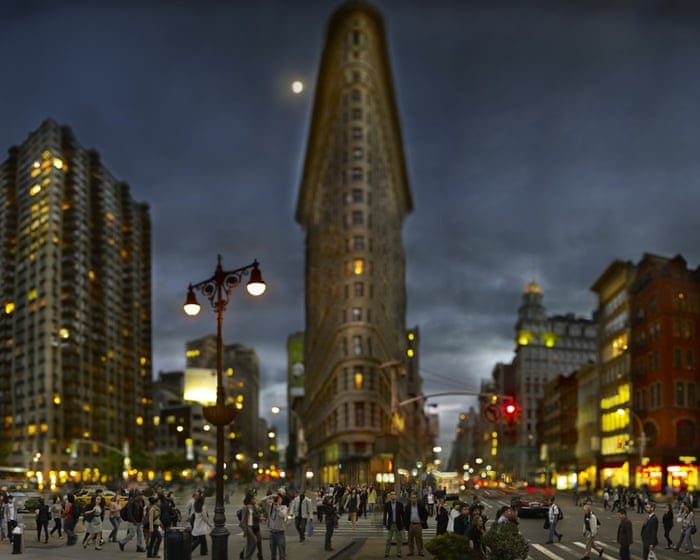Celebrate the place the Met calls home with our New York City Pinterest board featuring works depicting the Big Apple in all its splendor.http://met.org/1enZlCg
Samuel Halpert (American, 1884–1930) | The Flatiron Building | 1919
http://cn.tmagazine.com/art/20140923/t23twins/zh-hant/
How a Pair of Twins Redrew an Iconic Photograph With Camera-Like Precision
Look By Photographs by DAVID LA SPINA September 23, 2014
精準成像熨斗大廈,不用相機也不用針孔
圖片報導Photographs by DAVID LA SPINA 2014年09月23日

奧克斯兄弟想出一種辦法,能以針孔相機般的精準把他們面前的世界繪製到一個凹形網格上,不借助任何光學設備。
When Edward Steichen took his iconic photograph of the Flatiron Building in New York in 1904, the structure itself was only two years old, one of the tallest in the city and the very epitome of modernity. So it seemed the perfect challenge for the identical- twin artists Ryan and Trevor Oakes earlier this summer, a sidelight to the retrospective of their work I curated at the Museum of Mathematics, just up the road at 11 East 26th Street, open daily through Sept. 14. The brothers, who have been engaged in a deep colloquy on the nature of bifocal vision since toddlerhood, have recently developed one of the most intriguing breakthroughs in the depiction of physical reality since the Renaissance: They have come up with a method for tracing camera-obscura-exact renderings of the world before them onto a concave grid with no other optical equipment (no lenses, no pinholes) except their own unaided eyes. Lawrence Weschler
愛德華·斯泰肯(Edward Steichen)1904年拍攝他的標誌性作品——紐約熨斗大廈時,那座大廈剛建成兩年,是紐約最高的建築之一,也是現代性的象徵之作。所以今年夏初,它成了雙胞胎藝術家賴安和特雷弗·奧克斯(Ryan and Trevor Oakes)的絕佳挑戰,也是給我在熨斗大廈北邊不遠處東26街11號數學博物館(Museum of Mathematics )給他們策劃的作品回顧展造勢,該展覽每日開放,直至9月14日。兩兄弟小時就曾對雙焦視覺的本質進行過深刻討論,最近他們設計出了自文藝復興以來在描繪物理現實方面最有趣的突破:他們想出一種方法,能以針孔相機般的精準把他們面前的世界繪製到一個凹形網格上,不借助任何光學設備(不用鏡頭,也不用針孔),僅憑他們自己的眼睛。
First recorded mention of principles behind pinhole camera obscura: Mozi, Chinese philosopher (470-390 BC)
首個提到針孔相機原理的人:中國哲學家墨子(公元前470年至公元前390年)
First description and analysis of such a camera obscura:Ibn al-Haytham (Alhazan), Arab mathematician (965-1040 AD)
首個描述和分析這樣的針孔相機的人:阿拉伯數學家伊本·海賽姆(Ibn al-Haytham,965年至1040年)
European perfection and promulgation of camera obscura, with lenses: Giambattista della Porta's “Magia Naturalis” (1558-1589)
歐洲人對帶鏡頭的針孔相機的完善和普及:詹巴蒂斯塔·黛拉·波爾塔(Giambattista della Porta)的《自然魔術》(Magia Naturalis, 1558-1589)
Copyright © 2013 The New York Times Company. All rights reserved.
本文最初發表於2014年8月17日。譯:王相宜
本文內容版權歸紐約時報公司所有,任何單位及個人未經許可,不得擅自轉載或翻譯。
允晨文化
8月23日 · 編輯紀錄 ·
星期六的早晨,天氣晴朗,沿著三號國道從基隆往台北的路上,車行稀少。日照下,綠色的山巒連綿起伏,山巖的稜角立體而鮮明,像一匹厚實柔軟的綠絨,鋪展在大地之上,給人一種清新明澈的心情,好像就要踏上旅途了。其實,也蠻接近的,等會再帶幾本《105號公路》,就要往淡水有河書店去了。周末的藝文活動,透著一種疏懶愜意。不焦躁,不緊張。
進到辦公室,陽光的熱度更高了,但不想開冷氣,讓雪的意念進來吧——最近常有隱隱然要遁世的想頭,是因為歲入中年?還是世事太煩囂,無能為力?我找到一張在雪地上拍攝紐約熨斗大樓的照片。2007年的3月18日,在紐約遇到一場不期然的大暴雪,那場風雪讓我從華盛頓DC往紐約的路程中一共換了三列火車,後來才知道孫康宜教授和作家韓秀彼此通了電話,急切地想知道我後來安抵了紐約沒有。
三月的雪,多驚奇,沒有帶足禦寒的衣服,出了賓州車站,交通早已大亂,人潮湧動,完全攔不到車子,於是一咬牙,勇猛地踩進及脛的雪地上,拖著行李,從34街一直走到86街,到旅館時早已全身溼透,不知是汗是雪是雨,而後,在旅館裡瑟縮到天亮。
天亮後很興奮地到處走訪,看雪後初晴的紐約,粉底淡妝的大都會。當然,也到處拍照,其中就是這張了。第一次到紐約時曾在大都會博物館買了愛德華‧史泰欽所攝「熨斗大樓」的海報,深深被三角形的建築所吸引,那應該是開路和容積率造成的後果,造型十分戲劇化,讓人難忘。與原作相較,海報上接近單色的印刷,顯現不出原作充滿淡彩的畫意,和暈染的層次,意境深邃豐富。我拍的這張照片比起海報上的靜謐詩意更是望塵莫及,純粹是記憶一次的旅程,和意外的風雪。



沒有留言:
張貼留言